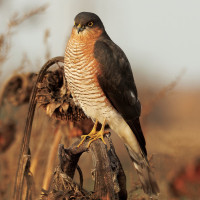Descrição
The Lee and Lincombe village area is designated as an Area of Outstanding Natural Beauty (AONB) and is between the town of Ilfracombe (see separate entry Ilfracombe Seafront and Harbour) 2 miles to the East and the long sandy beach of Woolacombe Sands to the West. Lee Bay, not to be confused with another Lee Bay further to the East (see separate entry Woody Bay- Crock Point - Lee Bay), is a rocky beach with numerous rock pools with some sandy areas, BE AWARE, CHECK TIDE TIMES IF EXPLORING ALONG BEACHES AND COVES, DANGER OF BEING CUT OFF BY THE TIDE.
The village of Lee is in a valley (called a Combe here), locally sometimes called 'The Fuchsia Valley' due to the many flowering Fuchsia plants, the village of Lee has a small car park (Fee Payable - Honesty Box) Toutinegra-de-barrette-preto can often be found here near the Lee Memorial Hall, nearer the beach is another car park (Free).
In the centre of Lee is the wonderfully named public house 'The Grampus Inn' (Grampus after the old name for Orca/Killer Whale), the area has some narrow roads and paths, many are steep and rough.
Six Acres Wood is wonderfully unkept and naturally wild. Look out for Estrelinha-de-poupa in areas of conifers and Pombo-bravo, Toutinegra-de-barrette-preto, Felosa-musical and Felosa-comum amongst deciduous woodland. The South West Coast Path East out of Lee Bay (see STAR on map) is also part of the long distance Tarka Trail, this part of the walk is good for numerous Cartaxo-comum, Cartaxo-nortenho and Papa-amoras-comum depending on season. Along the coast you may encounter falcão-peregrino, Ganso-patola and Corvo.
The beach (depending on tide) can hold Pilrito-sanderlingo, Ostraceiro and Petinha-marítima. This area is very underwatched by birdwatchers, one can only imagine how many rarities have been missed over the years.
Detalhes
Acesso
From the East leave Ilfracombe on Slade Road (not the A361 main road), that eventually becomes Higher Slade Road, on a sharp right turn follow road signs to Lincombe/Lee, the car park in Lee is on the Left Hand Side. From the beach side village of Woolacombe, leave along Beach Road (B3343), look for sharp left turn signed to Lincombe/Lee at road junction.
Terreno e Habitat
Floresta , Árvores e arbustos dispersos , Campina , Vale , Rio , Mar , Cidade/Vila , Agricultura , PraiaCondições
Plano , Montanhoso , Rochoso , Paisagem aberta , Possível na maré cheiaCaminho circular
Simé útil um telescópio?
Pode ser útilBoa temporada de observação de aves
Durante todo o anoMelhor hora para visitar
Migração da primavera , Migração de outono , Outono , PrimaveraRota
Estrada pavimentada , Caminho largo , Estrada não pavimentada , Caminho estreitoCaminho dificil
Caminhada médiaAcessível por
Pé , Bicicleta , CarroAbrigo/plataforma deobservação de aves
NãoInformação extra
Although not a major holiday destination, the area is becoming busier in the the Summer, a visit outside of this time or earlier in the day is advised, the smallish car parks can get full on busy days.



